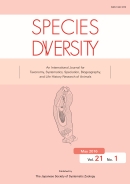Volume 14, Issue 3
Displaying 1-6 of 6 articles from this issue
- |<
- <
- 1
- >
- >|
-
Article type: Article
2009Volume 14Issue 3 Pages 157-164
Published: September 30, 2009
Released on J-STAGE: March 30, 2018
Download PDF (1210K) -
Article type: Article
2009Volume 14Issue 3 Pages 165-171
Published: September 30, 2009
Released on J-STAGE: March 30, 2018
Download PDF (1128K) -
Article type: Article
2009Volume 14Issue 3 Pages 173-196
Published: September 30, 2009
Released on J-STAGE: March 30, 2018
Download PDF (1902K) -
Article type: Article
2009Volume 14Issue 3 Pages 197-205
Published: September 30, 2009
Released on J-STAGE: March 30, 2018
Download PDF (671K) -
Article type: Article
2009Volume 14Issue 3 Pages 207-215
Published: September 30, 2009
Released on J-STAGE: March 30, 2018
Download PDF (565K) -
Article type: Article
2009Volume 14Issue 3 Pages 217-241
Published: September 30, 2009
Released on J-STAGE: March 30, 2018
Download PDF (3400K)
- |<
- <
- 1
- >
- >|
